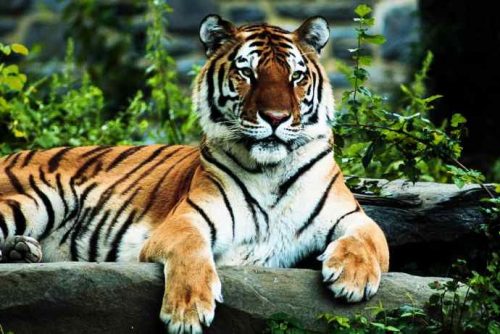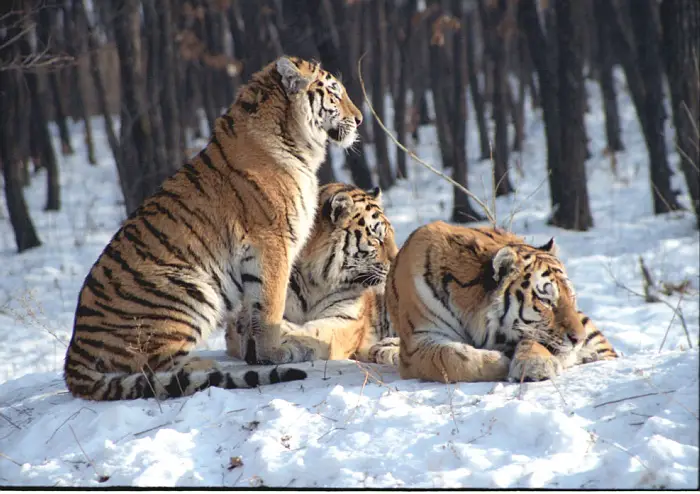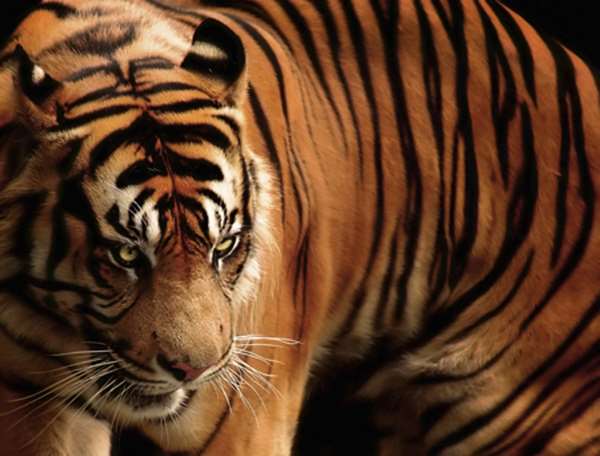Man always sees tigers as the symbol of pride, deepest fears, desires and aspirations. Tiger is typically sighted as the most fear-some predator which is admired for its lithe muscles, courage and beauty. Tigers are powerful animals that are capable to take down its prey single-handedly and subdue large prey. It has forelimbs and broad shoulders with the help of which tigers hold the prey while holding onto it with the retractable, long claws of the broad forepaws.
They are taller shoulder than at the rear, especially the Siberian and Bengal tigers averaging one meter high at the shoulder. Tigers have a tail measuring less than half the head and body length. Of all the big cats, or perhaps of all the endangered species, the tiger may be both the most charismatic and the most feared, as phrased in the timeless poem by William Blake.
Tigers (Panthera tigris) have long been recognized as the most dominant creature showing grace, rich coloring and powerful physique.
The adult male reaches a length of 9 – 9.5 feet (2.7 – 2.8 meters including tail that measures at 3-foot (90-cm). These cats stand 3-feet or more at the shoulder height, with the weight measuring at 400 – 660 pounds (180 – 300 kg).
Females are slightly less heavy than males; around a foot (30 cm) less in length and weighs around 100 pounds (40 kg) less. Tiger presents a reddish ground coat that turns out to be darker southward through the animal’s range. They have white undersides, with rare species being found that displays an entire white coat.
Learn More: Siberian Tiger Fun Facts

Interesting Tiger Information For Kids
- Tigers have the muscular bodies bearing strong and powerful forelimbs and large heads. The color of the coat varies, depending entirely on the subspecies. They also show prominent black stripes that run across its body. No tiger has stripes that resembles to the other tiger i.e. each one has its own unique stripes.
- The black stripes of tigers serve as a natural camouflage by hiding them in the shadows and the long grasses of their surroundings.
- Of all the extant felids, Siberian, Bengal and Caspian tigers are the largest size.
- The mean length of an adult male tiger living in Siberia or Northern India exceeds adult male lion by 45.5 kg (100 lb). There is a significant variation in the size of the females that typically measures 200 – 275 cm (79 – 108 inches), with the weight reaching at 65 – 167 kg (140 – 370 lb), bearing the largest skull ranging from 268 – 318 mm (10.6 – 12.5 inches).
- The length of the males measure around 250 – 390 cm (98 – 150 inches), with the weight measuring at 90 – 306 kg (200 – 670 lb), bearing the largest skull ranging from 316 – 383 mm (12.4 – 15.1 inches). According to scientists, the climatic change is mainly responsible for the size discrepancies in tigers.
- The adult Siberian tigers can be as large as 3.5 meters (11.5 ft), and weighs around 306 kg (670 lb). The Sumatran tiger grows to a length of 75 – 140 kg (170 – 310 lb).
- The length of the tail measures around 0.6 – 1.1 meters (2.0 – 3.6 ft). These cats stand 0.7 – 1.22 meters (2.3 – 4.0 ft) tall.
- Tigers are capable to reach a speed of 49 – 65 km/h (35 – 40 miles per hour).
See also:
Habitat Information about Tigers for Kids
In the primitive times, tigers had a widespread distribution and were found all throughout Asia, Caspian, Sea, Indonesian Islands of Bali, Java, Sumatra, and Caucasus. However, at the beginning of the 20th century, these cats began to disappear in the western Asia and were limited to few isolated pockets.
Currently, they are living in India, Southeast Asia, and China. Tigers also live in the Amur River in southeastern Siberia. Today, Sumatra is the only island that is exclusively occupied by tigers. They disappeared from the islands of Bali in 1940s; Caspian Sea in 1970s and from Java in 1980s. Human hunting is the primary cause of decline in population. Tigers are fond of water and they will live for years where water is abundant.
They are often swim in broad rivers in India. Bengal tigers occupy lush green forests, semi-evergreen of Assam, deciduous forests of Nepal, mangrove forests of Ganges Delta, and other thorn and swampy forests of Western Ghats and eastern Bengal respectively. Tigers fancy living in open grasslands including rocky habitats.
See also: Siberian Tiger Facts For Kids
Tigers once inhabited all along Asia ranging from eastern Turkey, Caspian Sea, including south of the Tibetan plateau and the Sea of Okhotsk. Sadly speaking, the tiger’s range has been limited to a few major habitats. At present, tigers have become extinct in Iran, Afghanistan, Turkey, and the Indus Valley of Pakistan. They were once widespread all throughout the India including the foothills of Himalaya, through Bhutan, Nepal, Sikkim, Myanmar, and Assam, and the population was dramatically reduced in the Indian Subcontinent.
They had also lived in Malaysia, Thailand, Vietnam, Cambodia, and Laos. Tigers have run out of their population in the islands of Java and Bali whereas in Sumatra a handful number of these species are usually found. Similarly, tigers once inhabited all across the eastern and southern China but now there are only few individuals remaining in these subtropical areas. They had also lived in large numbers in Korea, China, and Russia; unfortunately, the extreme human-hunting together with poaching makes tigers an endangered species.
Learn More: SIBERIAN TIGER ADAPTATIONS
Diet Information about Tigers
Tigers rely on medium-sized mammals for their daily consumption. They will prey on ungulates averaging 90 kg (200 lb). Some of the most common tigers prey includes chital, sambar, gaur, wild boar, water buffalo, barasingha, nilgai, and domestic buffalo. These are most frequent prey in India. Although on rare occasions, tigers also prey on sloth bears, crocodiles, leopards, and pythons.
Tigers hunt Manchurian wapiti and wild boar along with roe deer, musk deer, sika deer, and roe deer all throughout the Siberia. In Sumatra Island, tigers preferably hunt monkeys, yak, saiga antelopes, camels, Malayan tapir, Caucasian wisent, wild horses, followed by smaller prey such as peafowls, birds, porcupines, hares, and fish. They rarely take on adult elephants.
Like most mammalian predators, tigers are also opportunistic feeders and will consume anything ranging from medium-sized mammals to the small birds. Tigers typically prey on sambar and chital and it actually kills 4,221 kg of prey each year, while a leopard takes on 1,500 kg of prey, and dhole preys on 678 kg of prey.
See more:
Reproduction Information about Tigers
- The mating takes place all year round but it’s more usual in the months of November and April.
- The female is receptive for about three to six days.
- The gestation period lasts 93 – 112 days, with an average of 104 – 106 days.
- The female litters one to six cubs, with the typical range are two to three. The weight of the cubs measure around 680 – 1,400 grams (1.5 – 3.1 lb).
- These cubs are blind and deaf at their birth. The mother is normally responsible for guarding over the young and therefore, she finds some safer habitats such as in rocky crevices or caves.
- Half of the cubs do not reach maturity as other male tigers often kill them to make the female receptive.
- The juveniles begin to see after 6 – 14 days, and after a period of 8 weeks they will walk off from their den but will remain with their mother.
- The mother will nurse them for 3 – 6 moths. During this time, the cubs are learned to hunt.
- They will become independent after 18 months. The female reaches maturity age after 3 – 4 years, while males become mature after 4 – 5 years.
Endangered Tiger Information
Extinction lasts forever. It is sad to contemplate the extinction of an animal species due to the inexorable forces of nature. But, it is infinitely more depressing when the extinction is caused by supposedly responsible human beings. Tigers are endangered species probably due to excessive poaching and illegal hunting. Destruction of habitats is another reason for their population decline. In the beginning of the 20th century, there were more than 100,000 tigers in the wild; however, the numbers are declining in the wild habitats to 1,500 and 3,500.
Ecology and Behavior
Tigers are thought to live in a wide variety of habitats, ranging from tropical lowland evergreen forests to the monsoonal forests of Indo-Malaysia including the coniferous, birch woodlands, and scrub oak of Siberia. They had also lived in the mangrove swamps of Sundarbans of India and Bangladesh; in the north-central India they were found in the dry thorn forest; while in the southern Himalaya tigers exist in tall grass jungle.
See also: White Tiger Facts
Adaptations of a tiger inlcudes living in different climates, with some species also lives in an elevation of up to 3,960 meters in regions where winter dominates most of the time and the temperature averaging minus 30 degree to minus 40 degree centigrade. It follows that tigers have not a specific adaptability to live in particular habitats. The large prey is a sole preference of tigers; besides, there must be water besides their habitats for tigers to live on.
Read More: What Do Siberian Tigers Eat?
Tigers are found at higher densities where prey is more easily accessible. They are remarkable swimmers and in India they spend most of their time in water in the hot season. Tigers visit some islands of Sunda Strait where the currents travel at speed of 4 kilometers per hour. They rarely climb trees but they will, if provoked.
Subspecies
- Indochinese Tiger
- Bengal Tiger
- Malayan Tiger
- Sumatran Tiger
- Siberian Tiger
- South China Tiger
- Tasmanian Tiger
- Bali Tiger
- Caspian Tiger
- Javan Tiger







